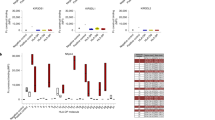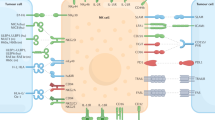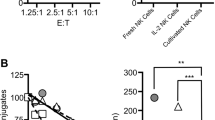Abstract
NKG2D (natural-killer group 2, member D) is a powerful activating receptor expressed by natural killer (NK) cells and T cells that regulates immune responses during infection, cancer and autoimmunity. NKG2D ligands comprise a diverse array of MHC-class-I-related proteins that are upregulated by cellular stress. Why is it beneficial for the host to have so many ligands for the same receptor? In this Opinion article, we propose that although competition with viruses is the most likely evolutionary drive for this diversity, there might be other explanations.
This is a preview of subscription content, access via your institution
Access options
Subscribe to this journal
Receive 12 print issues and online access
$209.00 per year
only $17.42 per issue
Buy this article
- Purchase on Springer Link
- Instant access to full article PDF
Prices may be subject to local taxes which are calculated during checkout



Similar content being viewed by others
References
Ljunggren, H. G. & Karre, K. In search of the 'missing self': MHC molecules and NK cell recognition. Immunol Today. 11, 237–244 (1990).
Bottino, C., Castriconi, R., Moretta, L. & Moretta, A. Cellular ligands of activating NK receptors. Trends Immunol. 26, 221–226 (2005).
Arase, H., Mocarski, E. S., Campbell, A. E., Hill, A. B. & Lanier, L. L. Direct recognition of cytomegalovirus by activating and inhibitory NK cell receptors. Science 296, 1323–1326 (2002).
Mandelboim, O. et al. Recognition of haemagglutinins on virus-infected cells by NKp46 activates lysis by human NK cells. Nature 409, 1055–1060 (2001).
Lanier, L. L. NK cell recognition. Annu. Rev. Immunol. 23, 225–274 (2005).
Raulet, D. H. Roles of the NKG2D immunoreceptor and its ligands. Nature Rev. Immunol. 3, 781–790 (2003).
Bottino, C. et al. Identification of PVR (CD155) and Nectin-2 (CD112) as cell surface ligands for the human DNAM-1 (CD226) activating molecule. J. Exp. Med. 198, 557–567 (2003).
Taieb, J. et al. A novel dendritic cell subset involved in tumor immunosurveillance. Nature Med. 12, 214–219 (2006).
Chan, C. W. et al. Interferon-producing killer dendritic cells provide a link between innate and adaptive immunity. Nature Med. 12, 207–213 (2006).
Lodoen, M. B. & Lanier, L. L. Natural killer cells as an initial defense against pathogens. Curr. Opin. Immunol. 18, 391–398 (2006).
Coudert, J. D. & Held, W. The role of the NKG2D receptor for tumor immunity. Semin. Cancer Biol. 16, 333–343 (2006).
Gasser, S., Orsulic, S., Brown, E. J. & Raulet, D. H. The DNA damage pathway regulates innate immune system ligands of the NKG2D receptor. Nature 436, 1186–1190 (2005).
Groh, V. et al. Cell stress-regulated human major histocompatibility complex class I gene expressed in gastrointestinal epithelium. Proc. Natl Acad. Sci. USA 93, 12445–12450 (1996).
Venkataraman, G. M., Suciu, D., Groh, V., Boss, J. M. & Spies, T. Promoter region architecture and transcriptional regulation of the genes for the MHC class I-related chain A and B ligands of NKG2D. J. Immunol. 178, 961–969 (2007).
Groh, V., Bruhl, A., El-Gabalawy, H., Nelson, J. L. & Spies, T. Stimulation of T cell autoreactivity by anomalous expression of NKG2D and its MIC ligands in rheumatoid arthritis. Proc. Natl Acad. Sci. USA 100, 9452–9457 (2003).
Hue, S. et al. A direct role for NKG2D/MICA interaction in villous atrophy during celiac disease. Immunity 21, 367–377 (2004).
Meresse, B. et al. Coordinated induction by IL15 of a TCR-independent NKG2D signaling pathway converts CTL into lymphokine-activated killer cells in celiac disease. Immunity 21, 357–366 (2004).
Ogasawara, K. et al. Impairment of NK cell function by NKG2D modulation in NOD mice. Immunity 18, 41–51 (2003).
Bahram, S., Bresnahan, M., Geraghty, D. E. & Spies, T. A second lineage of mammalian major histocompatibility complex class I genes. Proc. Natl Acad. Sci. USA 91, 6259–6263 (1994).
Bauer, S. et al. Activation of NK cells and T cells by NKG2D, a receptor for stress-inducible MICA. Science 285, 727–729 (1999).
Cosman, D. et al. ULBPs, novel MHC class I-related molecules, bind to CMV glycoprotein UL16 and stimulate NK cytotoxicity through the NKG2D receptor. Immunity 14, 123–133 (2001).
Chalupny, N., Sutherland, C., Lawrence, W., Rein-Weston, A. & Cosman, D. ULBP4 is a novel ligand for human NKG2D. Biochem. Biophys. Res. Commun. 305, 129–135 (2003).
Bacon, L. et al. Two human ULBP/RAET1 molecules with transmembrane regions are ligands for NKG2D. J. Immunol. 173, 1078–1084 (2004).
Diefenbach, A., Jamieson, A. M., Liu, S. D., Shastri, N. & Raulet, D. H. Ligands for the murine NKG2D receptor: expression by tumor cells and activation of NK cells and macrophages. Nature Immunol. 1, 119–126 (2000).
Cerwenka, A. et al. Retinoic acid early inducible genes define a ligand family for the activating NKG2D receptor in mice. Immunity 12, 721–727 (2000).
Carayannopoulos, L. N., Naidenko, O. V., Fremont, D. H. & Yokoyama, W. M. Murine UL16-binding protein-like transcript 1: a newly described transcript encoding a high-affinity ligand for murine NKG2D. J. Immunol. 169, 4079–4083 (2002).
Diefenbach, A., Hsia, J. K., Hsiung, M. Y. & Raulet, D. H. A novel ligand for the NKG2D receptor activates NK cells and macrophages and induces tumor immunity. Eur. J. Immunol. 33, 381–391 (2003).
Radosavljevic, M. et al. A cluster of ten novel MHC class I related genes on human chromosome 6q24.2–q25.3. Genomics 79, 114–123 (2002).
Stephens, H. A. MICA and MICB genes: can the enigma of their polymorphism be resolved? Trends Immunol. 22, 378–385 (2001).
Larson, J. H., Marron, B. M., Beever, J. E., Roe, B. A. & Lewin, H. A. Genomic organization and evolution of the ULBP genes in cattle. BMC Genomics 7, 227 (2006).
Sutherland, C. L. et al. ULBPs, human ligands of the NKG2D receptor, stimulate tumor immunity with enhancement by IL-15. Blood 108, 1313–1319 (2006).
Lilienfeld, B. G., Garcia-Borges, C., Crew, M. D. & Seebach, J. D. Porcine UL16-binding protein 1 expressed on the surface of endothelial cells triggers human NK cytotoxicity through NKG2D. J. Immunol. 177, 2146–2152 (2006).
Komatsu-Wakui, M. et al. MIC-A polymorphism in Japanese and a MIC-A-MIC-B null haplotype. Immunogenetics 49, 620–628 (1999).
French, A. R. et al. Escape of mutant double-stranded DNA virus from innate immune control. Immunity 20, 747–756 (2004).
Draghi, M. et al. NKp46 and NKG2D recognition of infected dendritic cells is necessary for NK cell activation in the human response to influenza infection. J. Immunol. 178, 2688–2698 (2007).
Pappworth, I. Y., Wang, E. C. & Rowe, M. The switch from latent to productive infection in Epstein–Barr virus-infected B cells is associated with sensitization to NK cell killing. J. Virol. 81, 474–482 (2007).
Welte, S. A. et al. Selective intracellular retention of virally induced NKG2D ligands by the human cytomegalovirus UL16 glycoprotein. Eur. J. Immunol. 33, 194–203 (2003).
Wu, J. et al. Intracellular retention of the MHC class I-related chain B ligand of NKG2D by the human cytomegalovirus UL16 glycoprotein. J. Immunol. 170, 4196–4200 (2003).
Dunn, C. et al. Human cytomegalovirus glycoprotein UL16 causes intracellular sequestration of NKG2D ligands, protecting against natural killer cell cytotoxicity. J. Exp. Med. 197, 1427–1439 (2003).
Valés-Goméz, M., Browne, H. & Reyburn, H. T. Expression of the UL16 glycoprotein of Human Cytomegalovirus protects the virus-infected cell from attack by natural killer cells. BMC Immunol. 4, 4 (2003).
Rolle, A. et al. Effects of human cytomegalovirus infection on ligands for the activating NKG2D receptor of NK cells: up-regulation of UL16-binding protein (ULBP)1 and ULBP2 is counteracted by the viral UL16 protein. J. Immunol. 171, 902–908 (2003).
Smith, H. R. et al. Recognition of a virus-encoded ligand by a natural killer cell activation receptor. Proc. Natl Acad. Sci. USA 99, 8826–8831 (2002).
Zou, Y., Bresnahan, W., Taylor, R. T. & Stastny, P. Effect of human cytomegalovirus on expression of MHC class I-related chains A. J. Immunol. 174, 3098–3104 (2005).
Chalupny, N. J., Rein-Weston, A., Dosch, S. & Cosman, D. Down-regulation of the NKG2D ligand MICA by the human cytomegalovirus glycoprotein UL142. Biochem. Biophys. Res. Commun. 346, 175–181 (2006).
Diefenbach, A., Jensen, E. R., Jamieson, A. M. & Raulet, D. H. Rae1 and H60 ligands of the NKG2D receptor stimulate tumour immunity. Nature 413, 165–171 (2001).
Cerwenka, A., Baron, J. L. & Lanier, L. L. Ectopic expression of retinoic acid early inducible-1 gene (RAE-1) permits natural killer cell-mediated rejection of a MHC class I-bearing tumor in vivo. Proc. Natl Acad. Sci. USA 98, 11521–11526 (2001).
Smyth, M. J. et al. NKG2D function protects the host from tumor initiation. J. Exp. Med. 202, 583–588 (2005).
Groh, V., Wu, J., Yee, C. & Spies, T. Tumour-derived soluble MIC ligands impair expression of NKG2D and T-cell activation. Nature 419, 734–738 (2002).
Castriconi, R. et al. Transforming growth factor β1 inhibits expression of NKp30 and NKG2D receptors: consequences for the NK-mediated killing of dendritic cells. Proc. Natl Acad. Sci. USA 100, 4120–4125 (2003).
Lee, J. C., Lee, K. M., Kim, D. W. & Heo, D. S. Elevated TGF-β1 secretion and down-modulation of NKG2D underlies impaired NK cytotoxicity in cancer patients. J. Immunol. 172, 7335–7340 (2004).
Vetter, C. S., Lieb, W., Brocker, E. B. & Becker, J. C. Loss of nonclassical MHC molecules MIC-A/B expression during progression of uveal melanoma. Br. J. Cancer 91, 1495–1499 (2004).
Pende, D. et al. Major histocompatibility complex class I-related chain A and UL16-binding protein expression on tumor cell lines of different histotypes: analysis of tumor susceptibility to NKG2D-dependent natural killer cell cytotoxicity. Cancer Res. 62, 6178–6186 (2002).
Salih, H. R. et al. Functional expression and release of ligands for the activating immunoreceptor NKG2D in leukemia. Blood 102, 1389–1396 (2003).
Poggi, A. et al. Vδ1 T lymphocytes from B-CLL patients recognize ULBP3 expressed on leukemic B cells and up-regulated by trans-retinoic acid. Cancer Res. 64, 9172–9179. (2004).
Eisele, G. et al. TGF-β and metalloproteinases differentially suppress NKG2D ligand surface expression on malignant glioma cells. Brain 129, 2416–2425 (2006).
Raffaghello, L. et al. Downregulation and/or release of NKG2D ligands as immune evasion strategy of human neuroblastoma. Neoplasia 6, 558–568 (2004).
Eagle, R. A., Traherne, J. A., Ashiru, O., Wills, M. R. & Trowsdale, J. Regulation of NKG2D ligand gene expression. Hum. Immunol. 67, 159–169 (2006).
Boissel, N. et al. BCR/ABL oncogene directly controls MHC class I chain-related molecule A expression in chronic myelogenous leukemia. J. Immunol. 176, 5108–5116 (2006).
Armeanu, S. et al. Natural killer cell-mediated lysis of hepatoma cells via specific induction of NKG2D ligands by the histone deacetylase inhibitor sodium valproate. Cancer Res. 65, 6321–6329 (2005).
Nielsen, R. et al. A scan for positively selected genes in the genomes of humans and chimpanzees. PLoS Biol. 3, e170 (2005).
Crespi, B. J. & Summers, K. Positive selection in the evolution of cancer. Biol. Rev. Camb. Philos. Soc. 81, 407–424 (2006).
Shankaran, V. et al. IFNγ and lymphocytes prevent primary tumour development and shape tumour immunogenicity. Nature 410, 1107–1111 (2001).
Gourzi, P., Leonova, T. & Papavasiliou, F. N. A role for activation-induced cytidine deaminase in the host response against a transforming retrovirus. Immunity 24, 779–786 (2006).
Routes, J. M. et al. Adenovirus serotype 5 E1A sensitizes tumor cells to NKG2D-dependent NK cell lysis and tumor rejection. J. Exp. Med. 202, 1477–1482 (2005).
McFarland, B. J. & Strong, R. K. Thermodynamic analysis of degenerate recognition by the NKG2D immunoreceptor: not induced fit but rigid adaptation. Immunity 19, 803–812 (2003).
O'Callaghan, C. A., Cerwenka, A., Willcox, B. E., Lanier, L. L. & Bjorkman, P. J. Molecular competition for NKG2D: H60 and RAE1 compete unequally for NKG2D with dominance of H60. Immunity 15, 201–211 (2001).
Steinle, A. et al. Interactions of human NKG2D with its ligands MICA, MICB, and homologs of the mouse RAE-1 protein family. Immunogenetics 53, 279–287 (2001).
Davis, D. M. & Dustin, M. L. What is the importance of the immunological synapse? Trends Immunol. 25, 323–327. (2004).
Eleme, K. et al. Cell surface organization of stress-inducible proteins ULBP and MICA that stimulate human NK cells and T cells via NKG2D. J. Exp. Med. 199, 1005–1010 (2004).
Gleimer, M. & Parham, P. Stress management: MHC class I and class I-like molecules as reporters of cellular stress. Immunity 19, 469–477 (2003).
Borchers, M. T., Harris, N. L., Wesselkamper, S. C., Vitucci, M. & Cosman, D. NKG2D ligands are expressed on stressed human airway epithelial cells. Am. J. Physiol. Lung Cell Mol. Physiol. 291, L222–231 (2006).
Suemizu, H. et al. A basolateral sorting motif in the MICA cytoplasmic tail. Proc. Natl Acad. Sci. USA 99, 2971–2976 (2002).
Nomura, M. et al. Genomic structures and characterization of Rae1 family members encoding GPI-anchored cell surface proteins and expressed predominantly in embryonic mouse brain. J. Biochem. (Tokyo) 120, 987–995 (1996).
Ogasawara, K., Benjamin, J., Takaki, R., Phillips, J. H. & Lanier, L. L. Function of NKG2D in natural killer cell-mediated rejection of mouse bone marrow grafts. Nature Immunol. 6, 938–945 (2005).
Poggi, A. et al. Interaction between human NK cells and bone marrow stromal cells induces NK cell triggering: role of NKp30 and NKG2D receptors. J. Immunol. 175, 6352–6360 (2005).
Mincheva-Nilsson, L. et al. Placenta-derived soluble MHC class I chain-related molecules down-regulate NKG2D receptor on peripheral blood mononuclear cells during human pregnancy: a possible novel immune escape mechanism for fetal survival. J. Immunol. 176, 3585–3592 (2006).
Hamerman, J. A., Ogasawara, K. & Lanier, L. L. Cutting edge: Toll-like receptor signaling in macrophages induces ligands for the NKG2D receptor. J. Immunol. 172, 2001–2005 (2004).
Nedvetzki, S. et al. Reciprocal regulation of natural killer cells and macrophages associated with distinct immune synapses. Blood 109, 3776–3785 (2007).
Rabinovich, B. A. et al. Activated, but not resting, T cells can be recognized and killed by syngeneic NK cells. J. Immunol. 170, 3572–3576 (2003).
Molinero, L. L., Fuertes, M. B., Rabinovich, G. A., Fainboim, L. & Zwirner, N. W. Activation-induced expression of MICA on T lymphocytes involves engagement of CD3 and CD28. J. Leukoc. Biol. 71, 791–797 (2002).
Ferlazzo, G. et al. The abundant NK cells in human secondary lymphoid tissues require activation to express killer cell Ig-like receptors and become cytolytic. J. Immunol. 172, 1455–1462 (2004).
Tieng, V. et al. Binding of Escherichia coli adhesin AfaE to CD55 triggers cell-surface expression of the MHC class I-related molecule MICA. Proc. Natl Acad. Sci. USA 99, 2977–2982 (2002).
Ogasawara, K. et al. NKG2D blockade prevents autoimmune diabetes in NOD mice. Immunity 20, 757–767 (2004).
Groh, V., Smythe, K., Dai, Z. & Spies, T. Fas-ligand-mediated paracrine T cell regulation by the receptor NKG2D in tumor immunity. Nature Immunol. 7, 755–762 (2006).
Saez-Borderias, A. et al. Expression and function of NKG2D in CD4+ T cells specific for human cytomegalovirus. Eur. J. Immunol. 36, 3198–3206 (2006).
Garrity, D., Call, M. E., Feng, J. & Wucherpfennig, K. W. The activating NKG2D receptor assembles in the membrane with two signaling dimers into a hexameric structure. Proc. Natl Acad. Sci. USA 102, 7641–7646 (2005).
González, S., Groh, V. & Spies, T. Immunobiology of human NKG2D and its ligands. Curr. Top. Microbiol. Immunol. 298, 121–138 (2006).
Wills, M. R. et al. Human cytomegalovirus encodes an MHC class I-like molecule (UL142) that functions to inhibit NK cell lysis. J. Immunol. 175, 7457–7465 (2005).
Abreu, M. T., Fukata, M. & Arditi, M. TLR signaling in the gut in health and disease. J. Immunol. 174, 4453–4460 (2005).
Leelayuwat, C., Townend, D. C., Degli-Esposti, M. A., Abraham, L. J. & Dawkins, R. L. A new polymorphic and multicopy MHC gene family related to nonmammalian class I. Immunogenetics 40, 339–351 (1994).
Onda, H. et al. A novel secreted tumor antigen with a glycosylphosphatidylinositol-anchored structure ubiquitously expressed in human cancers. Biochem. Biophys. Res. Commun. 285, 235–243 (2001).
Conejo-Garcia, J. R. et al. Letal, A tumor-associated NKG2D immunoreceptor ligand, induces activation and expansion of effector immune cells. Cancer Biol. Ther. 2, 446–451 (2003).
Krmpotic, A. et al. MCMV glycoprotein gp40 confers virus resistance to CD8+ T cells and NK cells in vivo. Nature Immunol. 3, 529–535 (2002).
Lodoen, M. et al. NKG2D-mediated natural killer cell protection against cytomegalovirus is impaired by viral gp40 modulation of retinoic acid early inducible 1 gene molecules. J. Exp. Med. 197, 1245–1253 (2003).
Lodoen, M. B. et al. The cytomegalovirus m155 gene product subverts natural killer cell antiviral protection by disruption of H60–NKG2D interactions. J. Exp. Med. 200, 1075–1081 (2004).
Hasan, M. et al. Selective down-regulation of the NKG2D ligand H60 by mouse cytomegalovirus m155 glycoprotein. J. Virol. 79, 2920–2930 (2005).
Lenac, T. et al. The herpesviral Fc receptor fcr-1 down-regulates the NKG2D ligands MULT-1 and H60. J. Exp. Med. 203, 1843–1850 (2006).
Krmpotic, A. et al. NK cell activation through the NKG2D ligand MULT-1 is selectively prevented by the glycoprotein encoded by mouse cytomegalovirus gene m145. J. Exp. Med. 201, 211–220 (2005).
Acknowledgements
The authors thank the Isaac Newton Trust (Cambridge, UK) and Cancer Research UK for grant support to R.A.E. and the Wellcome Trust (UK) to J.T. Thanks also to D. Davis, H. Reyburn, A. Tripati, and M. Wills for critical reading of the manuscript.
Author information
Authors and Affiliations
Ethics declarations
Competing interests
The authors declare no competing financial interests.
Related links
Rights and permissions
About this article
Cite this article
Eagle, R., Trowsdale, J. Promiscuity and the single receptor: NKG2D. Nat Rev Immunol 7, 737–744 (2007). https://doi.org/10.1038/nri2144
Published:
Issue Date:
DOI: https://doi.org/10.1038/nri2144
This article is cited by
-
NKG2D knockdown improves hypoxic-ischemic brain damage by inhibiting neuroinflammation in neonatal mice
Scientific Reports (2024)
-
Natural killer cells: a promising immunotherapy for cancer
Journal of Translational Medicine (2022)
-
Dysfunction of natural killer cells in end-stage kidney disease on hemodialysis
Renal Replacement Therapy (2021)
-
Natural killer cells as a promising therapeutic target for cancer immunotherapy
Archives of Pharmacal Research (2019)
-
Distinct expression profile of HCMV encoded miRNAs in plasma from oral lichen planus patients
Journal of Translational Medicine (2017)



